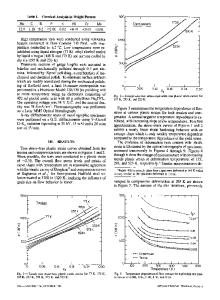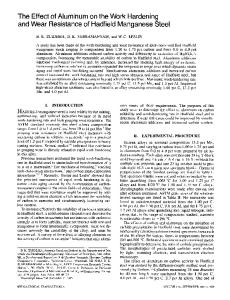Effects of laser-shock processing on the microstructure and surface mechanical properties of hadfield manganese steel
- PDF / 3,392,300 Bytes
- 11 Pages / 613 x 788.28 pts Page_size
- 18 Downloads / 439 Views
I.
INTRODUCTION
LASER-SHOCK processing (LSP) of metals has been shown in many studies to modify surface microstructure and improve mechanical propertiesJ ~-~5~ Shock waves generated in LSP originate from a plasma volume expansion formed on the material surface when it is irradiated with a laser operated in a nanosecond or subnanosecond range with power densities typically greater than 108 W / c m z. This shock wave generation alters the surface microstructure and mechanical properties of material. Since the 1970s, metallurgical effects of LSP on various materials have been the subject of a number of studies: early work by Fairand e t al. tq and Clauer and co-workers l~-~~ on aluminum and ferrous alloys, recent investigations by Fournier and co-workers on a nickel alloy, 1~3,~41and by Bana~ e t al. on a maraging steel, t~51 These studies showed that LSP improves material mechanical properties such as hardness and fatigue strength. The increase in the fatigue strength appears to be due to surface compressive residual stresses introduced by the s h o c k w a v e s . [7-15] The increase in hardness and yield strength is attributed to the laser-shock-wave-generated high density arrays of dislocations in several alloys ttsl and formation of deformation twins in some ferrous alloys, l~61In addition, it has been demonstrated that when no coating is used on the material, LSP causes severe material melting and vaporization, resulting in resolidified droplets, craters, t4'5~ and splashlike features Hz'~7-wl on the surface. Thus, to protect the surfaces, J.P. CHU, Associate Professor, is with the Institute of Materials Engineering, National Taiwan Ocean University, Keelung, Taiwan, Republic of China. J.M. RIGSBEE, Professor, is with the Department of Materials Science and Engineering, University of Alabama at Birmingham, Birmingham, AL 35294-4461. G. BANAS, Research Engineer, and F.V. LAWRENCE, Professor, are with the Department of Civil Engineering, University of Illinois at Urbana-Champaign, Urbana, IL 61801. H.E. ELSAYED-ALI, Associate Professor, is with the Department of Electrical and Computer Engineering, Old Dominion University, Norfolk, VA 23529. Manuscript submitted April 25, 1994. METALLURGICAL AND MATERIALS TRANSACTIONS A
energy-absorbing coatings (such as black paint) must be applied to the material prior to LSP. t61 Furthermore, to obtain greater shock-wave intensities, an overlay transparent to the laser wavelength is used to confine the plasma volume expansion to the interface region of the target material and overlay.[2~ Increases of up to two orders of magnitude in shock-wave intensity for the confined configuration have been recently reported by Fabbro e t al. t241 when compared with the direct configuration. However, a laser-induced breakdown of the overlay that leads to a substantial laser power loss has been found to limit the use of this configuration for LSP operated at high laser-power densities (> 101~ W / c m 2).[24"25] The main objectives of this study are to examine the LSP effects on the microst
Data Loading...











